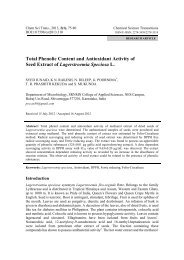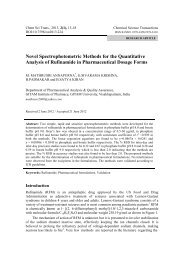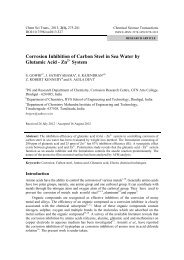Full Text - Chemical Science Transactions
Full Text - Chemical Science Transactions
Full Text - Chemical Science Transactions
You also want an ePaper? Increase the reach of your titles
YUMPU automatically turns print PDFs into web optimized ePapers that Google loves.
420 Chem Sci Trans., 2013, 2(2), 413-422<br />
Percentage of moisture content<br />
Concentration of alkali<br />
Figure 3. Comparison of moisture absorption studies of untreated and 5% acrylic acid<br />
treated abaca fiber with 5%, 10% and 15 % NaOH pre-treatment<br />
To summarise, natural fibers are made up of cellulose, hemicellulose and lignin. The<br />
cellulose is held together by amorphous hemicelluloses and fibers are cemented together in the<br />
plant by lignin. Lignocellulosics cell wall polymers contain hydroxyl and other oxygen<br />
containing groups that attract moisture through hydrogen bonding. The hemicellulose is mainly<br />
responsible for moisture absorption, but the accessible cellulose, noncrystalline cellulose, lignin<br />
and surface of crystalline cellulose also play major roles. Reduction in moisture uptake by the<br />
treated fiber may be due the partial removal of lignin and hemicellulose component of fiber by<br />
chemical treatment. Also, in all natural cellulose fibers, a hollow cavity called lumen exists in the<br />
unit cell of the fibers 48 . The hollow cavity generates more pathways for water to start diffusing<br />
into the fiber. The velocity of the diffusion process can be reduced by reducing the void content<br />
of the fiber. The cellular structure of the fiber is destroyed by the chemical treatment; hence<br />
reduced the void content and this in turn reduced the moisture uptake of treated fiber.<br />
Conclusion<br />
The potential of using natural fibers as reinforcing agents is based on the interfacial properties<br />
between fiber and polymer matrix. Also, the poor resistance of the fibers to water absorption<br />
can have undesirable effects on the structure, dimensional and mechanical properties of the<br />
natural fiber reinforced composites. It is possible to reduce the moisture absorption property of<br />
abaca fiber through its surface modification. The results presented in this work indicate that the<br />
abaca fiber treated with acrylic acid absorbs less moisture than the untreated.<br />
Acknowledgement<br />
The first author would like to thank the Management of KLE Society’s BVB College of<br />
Engineering and Technology, Hubli, Karnataka, India for the kind encouragement and constant<br />
support provided. She sincerely thanks Prof. Ashok Shettar, Principal, KLE Society’s BVB<br />
College of Engineering and Technology, without his encouragement and motivation, this work<br />
would not have been possible. The second author would like to thank Dr. M. Mohan Alva,<br />
Chairman, Alva’s Education Foundation, for his kind encouragement and support provided.<br />
The third author would like to thank Sri G. M. Lingaraju, Secretary, GM Institute of<br />
Technology, Davangere, India, for their encouragement and support throughout this work.





